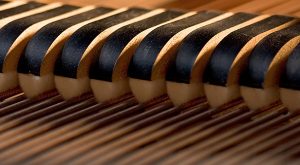It’s Science! Basic Acoustics: Frequency, Wavelength & Pitch
Music is the wondrous meeting place of art and science. Part One of “It’s Science!”explained how the volume of a sound is determined by the amplitude of the sound wave. Sound waves have many other characteristics besides amplitude; otherwise, dropping a dinner plate would sound like playing a trumpet!
Frequency: Why “Re” Is Different from “Mi”

When you watch waves roll onto a beach, you not only notice how high the waves are (their amplitude), but also how rapidly they follow each other. If you were to count how many wave crests reach the shore in a minute, you would be finding the frequency of the waves. Likewise, the frequency of a sound wave is measured by how many air vibrations reach our eardrums every second.
Frequency is what makes one note different from another, in a very simple way: higher frequency means higher pitch. Booming bass notes have very low frequencies, while piercing treble notes have very high frequencies.
Fun fact: Frequency doubles every octave. Therefore, the frequency of the note middle C is exactly twice the frequency of the note C an octave lower.
The question all of this raises is, if frequency determines pitch, why don’t all instruments sound the same when the same note is played on them? This question reveals the “great secret” of musical instruments: they never produce just one frequency at a time! Each time you play a note on any instrument, in addition to the main frequency (the note we can identify), a whole bunch of other waves with different frequencies and smaller amplitudes are created. These other waves are called the “overtones” of the main note. We don’t register them in our minds because they are so much quieter than the main note, but we do hear them; they shape our perception of the timbre (quality of sound) of the instrument. Each instrument produces a different blend of overtones, which is why a violin never sounds like a flute.
No wonder studying music helps students do better in math and science!
On the Same Wavelength: How a Trombone and a Slide Whistle are Basically the Same

Returning to waves hitting the beach, you could also measure the distance between “peaks”—that is, how many meters separate one wave crest from the next. This measurement is the wavelength of the waves. Wavelength and frequency are closely related: If you change the wavelength of a sound wave, you also change the frequency, creating a new pitch. That explains why pressing down the string of a cello or guitar with your finger changes the note that you hear: By shortening the length of string that is free to vibrate, you shorten the wavelength of the sound wave, so the frequency changes, too.
Fun fact: The hammers of a piano strike the strings 1/7 of the way along their length in order to silence the 7th overtone of the main note, which is often considered harsher in sound.
Similarly, the valves and keys of brass and woodwind instruments alter the instruments’ air columns to change the wavelength of the sound waves created. An even simpler way to change wavelength, however, would be to shorten or lengthen the entire air column. That is how a slide whistle works, and why it is a very old instrument. A slide trombone works in exactly the same way—each time the slide is moved, the wavelength of the sound waves gets longer or shorter.
Putting It All Together: The Great Bass Mystery Solved
The relationship between wavelength and frequency is actually very specific: As frequency increases, wavelength decreases. In other words, if a note has a very low frequency, it will have a very long wavelength. If the frequency of a pitch is very high, its wavelength will be very short. As it happens, wavelength determines how far a sound wave can travel. Shorter wavelengths die out more quickly as the wave moves through the air.
That is why you only hear the bass and drums when a band is playing at the far end of the park. The low-frequency notes produced by basses and tom-toms have ultra-long wavelengths, so they travel much farther than the higher-frequency, short-wavelength notes of the guitars, singers, and cymbals. It really is all science!
The Science in Practice: Audio Engineering
People who apply scientific ideas to real-world problems are called engineers. It should come as no surprise, therefore, that the people who run recording studios or operate the sound equipment at a concert are called sound or audio engineers. If you are interested in exploring the world of acoustics more deeply, we offer a variety of products to get you started in audio engineering.




